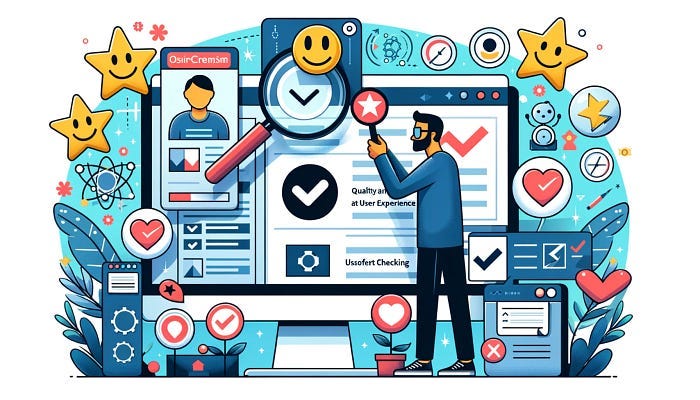
The Importance of User-Centric Testing
As software testers, we play a crucial role in ensuring the quality and reliability of the applications we work on. However, it’s easy to fall into the trap of becoming a “ticket tester” — focusing solely on checking off requirements and closing tickets without considering the bigger picture. To truly make a difference and deliver exceptional software, we must adopt a user-centric approach to testing.
Understanding the User’s Perspective
One of the most important aspects of user-centric testing is putting ourselves in the shoes of the end-user. We need to understand their needs, expectations, and pain points. By doing so, we can identify issues that may not be apparent from a purely technical standpoint.
For example, a feature may work perfectly according to the specifications, but if it’s difficult to navigate or understand from a user’s perspective, it can still be considered a failure. By testing with empathy and considering the user experience, we can uncover these usability issues and advocate for improvements.
To gain a deeper understanding of the user’s perspective, we can employ various techniques such as user personas, user journey mapping, and usability testing. User personas help us create fictional representations of our target users, including their goals, behaviors, and pain points. User journey mapping allows us to visualize the steps a user takes to achieve a specific goal within the application, highlighting potential areas of friction or confusion. Usability testing involves observing real users as they interact with the software, gathering valuable feedback and insights into their experience.
By incorporating these techniques into our testing process, we can develop a more comprehensive understanding of the user’s needs and ensure that our testing efforts are aligned with their expectations.
Going Beyond the Tickets
While it’s important to ensure that all the requirements outlined in the tickets are met, a user-centric approach requires us to go beyond just checking boxes. We need to think critically about how the software will be used in real-world scenarios and explore edge cases that may not have been considered during the development process.
This means taking the time to perform exploratory testing, trying out different workflows, and considering the various ways users may interact with the application. By doing so, we can identify potential issues and provide valuable feedback to the development team.
Exploratory testing allows us to step outside the confines of predefined test cases and discover unexpected behaviors or usability issues. It involves using our creativity and domain knowledge to test the application in ways that may not have been anticipated during the planning phase. This type of testing can uncover hidden defects and provide insights into how the software behaves under different conditions.
In addition to exploratory testing, we should also consider the various user roles and permissions within the application. Testing with different user profiles and access levels can reveal potential security vulnerabilities or inconsistencies in the user experience. By thoroughly testing these scenarios, we can ensure that the software is secure and provides a consistent experience for all users, regardless of their role or permissions.
Collaborating with Cross-Functional Teams
User-centric testing also involves collaborating closely with cross-functional teams, including designers, product managers, and customer support representatives. These teams have valuable insights into user behavior, feedback, and pain points that can inform our testing efforts.
By working together and sharing knowledge, we can develop a more comprehensive understanding of the user’s needs and ensure that the software we deliver meets their expectations. This collaboration also allows us to provide input early in the development process, catching potential issues before they become more difficult and expensive to fix.
Regular communication and collaboration with designers can help us understand the user experience goals and design principles behind the application. We can provide feedback on the usability and accessibility of the design, ensuring that it aligns with the needs of the target users. Product managers can share valuable insights into the business objectives and user requirements, helping us prioritize our testing efforts and focus on the most critical aspects of the application.
Customer support representatives are another valuable source of information, as they have direct contact with users and can provide real-world feedback on common issues and pain points. By collaborating with customer support, we can identify recurring problems and prioritize testing scenarios that address these concerns. This collaboration helps us create a more robust and user-friendly application that reduces the burden on customer support and improves overall user satisfaction.
Advocating for the User
As software testers, we have a unique opportunity to be the voice of the user within the development process. By adopting a user-centric approach, we can advocate for their needs and push for improvements that will enhance their experience.
This means not being afraid to raise concerns, even if they may not be popular or easy to address. It also means being proactive in suggesting improvements and collaborating with the team to find solutions that prioritize the user’s needs.
To effectively advocate for the user, we need to communicate our findings and recommendations clearly and persuasively. This involves presenting data-driven insights, using specific examples and scenarios to illustrate the impact on the user experience. We should also be prepared to discuss the potential business benefits of addressing these issues, such as increased user adoption, reduced support costs, and improved customer satisfaction.
It’s important to remember that advocating for the user is not about placing blame or creating conflict within the team. Instead, it’s about fostering a collaborative environment where everyone is working towards the common goal of delivering high-quality, user-centric software. By approaching these discussions with empathy, respect, and a solutions-oriented mindset, we can effectively advocate for the user’s needs while maintaining a positive and productive team dynamic.
In today’s competitive software landscape, delivering a great user experience is more important than ever. As software testers, we have a critical role to play in ensuring that the applications we work on meet the needs and expectations of our users.
By adopting a user-centric approach to testing, going beyond just checking tickets, collaborating with cross-functional teams, and advocating for the user’s needs, we can make a real difference in the quality and success of the software we deliver. Let’s embrace this mindset and strive to be more than just ticket testers — let’s be champions for our users.
Ultimately, the success of our software depends on the satisfaction and loyalty of our users. By putting their needs at the forefront of our testing efforts, we can create applications that not only meet the technical requirements but also exceed user expectations. This user-centric approach to testing requires a shift in mindset, a willingness to collaborate, and a commitment to continuous improvement.
As software testers, we have the power to shape the future of the applications we work on. By embracing a user-centric testing philosophy, we can make a lasting impact on the quality and success of the software we deliver. Let’s take pride in our role as user advocates and work tirelessly to ensure that every user has an exceptional experience with the applications we help bring to life.






